#Men Shirts Market analysis
Explore tagged Tumblr posts
Text
Men Shirts Market trends, and forecasts from 2024 to 2034
The Men Shirts market report offered by Reports Intellect is meant to serve as a helpful means to evaluate the market together with an exhaustive scrutiny and crystal-clear statistics linked to this market. The report consists of the drivers and restraints of the Men Shirts Market accompanied by their impact on the demand over the forecast period. Additionally, the report includes the study of prospects available in the market on a global level. With tables and figures helping evaluate the Global Men Shirts market, this research offers key statistics on the state of the industry and is a beneficial source of guidance and direction for companies and entities interested in the market. This report comes along with an additional Excel data-sheet suite taking quantitative data from all numeric forecasts offered in the study.
Get Sample PDF Brochure @ https://www.reportsintellect.com/sample-request/2364513
Key players offered in the market: Heilan Home Youngor Lu Thai Textile Co.,Ltd Saint Angelo Seven Brand Roman Group Hodo JOEONE G2000 Goldlion Semir Giuseppe Septwolves
Additionally, it takes account of the prominent players of the Men Shirts market with insights including market share, product specifications, key strategies, contact details, and company profiles. Similarly, the report involves the market computed CAGR of the market created on previous records regarding the market and existing market trends accompanied by future developments. It also divulges the future impact of enforcing regulations and policies on the expansion of the Men Shirts Market.
Scope and Segmentation of the Men Shirts Market
The estimates for all segments including type and application/end-user have been provided on a regional basis for the forecast period from 2024 to 2034. We have applied a mix of bottom-up and top-down methods for market estimation, analyzing the crucial regional markets, dynamics, and trends for numerous applications. Moreover, the fastest & slowest growing market segments are pointed out in the study to give out significant insights into each core element of the market.
Men Shirts Market Type Coverage: - Cotton Men Shirts Polyester Men Shirts Linen Men Shirts Other Men Shirts
Men Shirts Market Application Coverage: - Leisure Business
Regional Analysis:
North America Country (United States, Canada) South America Asia Country (China, Japan, India, Korea) Europe Country (Germany, UK, France, Italy) Other Countries (Middle East, Africa, GCC)
Also, Get an updated forecast from 2024 to 2034.
Discount PDF Brochure @ https://www.reportsintellect.com/discount-request/2364513
The comprehensive report provides:
Reasons to Purchase Men Shirts Market Research Report
Covid-19 Impact Analysis: Our research analysts are highly focused on the Men Shirts Market covid-19 impact analysis. A whole chapter is dedicated to the covid-19 outbreak so that our clients get whole and sole details about the market ups & downs. With the help of our report the clients will get vast statistics as to when and where should they invest in the industry.
Contact Us: [email protected] Phone No: + 1-706-996-2486 US Address: 225 Peachtree Street NE, Suite 400, Atlanta, GA 30303
#Men Shirts Market#Men Shirts Market trends#Men Shirts Market future#Men Shirts Market size#Men Shirts Market growth#Men Shirts Market forecast#Men Shirts Market analysis
0 notes
Text
Kitchener Essences: David Duchovny
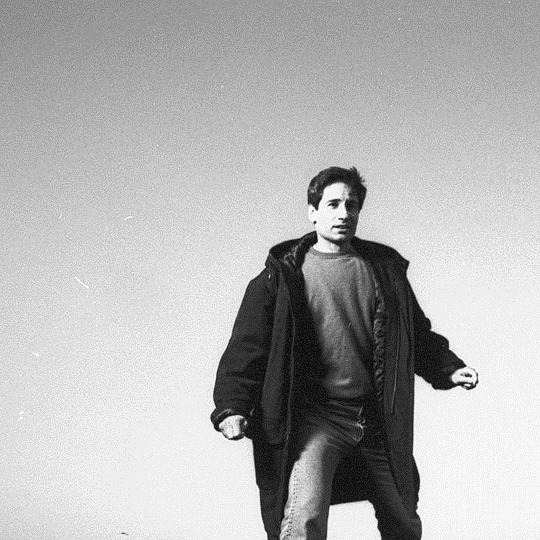
Already tackled Gillian Anderson's essence here, so, it's David's turn!
John Kitchener, like Kibbe, created his system on top of the yin-yang methodology other stylists were constructing in the early 20th century. Yet instead of focusing on the body's structure as a whole (Kibbe's method), Kitchener zeroed in on the face: particularly, its holistic expression.
ESSENCES AND THE ENTERTAINMENT INDUSTRY

(Credit to: Ellie-Jean Royden)
I'd previously written a post about the Feminine vs. Masculine balance in David Duchovny's face (post here); but found, as I was working on this project, that that method and the Kitchener method overlap each other. Both assess the yin (soft, rounded, curved lines) and yang (sharp, narrow or blunt, chiseled lines) of a person's face; and draw up a general impression others would have of them at a neutral first glance.
These tools may not appeal to everyone; but boy do they work hand and glove in the entertainment industry. Actors can disguise their natural essence in a role by embodying another person; can tone down their masculine vs. feminine balance with hair, makeup, and styling; and can lean into their natural aura for promotion and marketing. Of course, there is some degree of typecasting-- it would be harder (or impossible) for a person with Gamine Essence (smaller facial features with dynamic odds and ends) to pull off an Ethereal Essence (long, sleek, elongated, elegant lines) than it would for an Ethereal to pull off a Dramatic Essence (as Cate Blanchett did for Thor: Ragnarök.) This system also effectually proves Kibbe's warning: one cannot evaluate a person's Kibbe body type by the face alone-- Ingenue Leonardo DiCaprio and Classic (if I recall) Colin Firth are both Romantics, after all. Similarly, 5'2" Kibbe Theatrical Romantic Gillian Anderson and 5'10" Kibbe Dramatic Tilda Swinton share a striking Ethereal Essence.
**Note**: If you don't care to ingest the full post, skip straight to the DAVID DUCHOVNY header for his analysis.
DECODING KITCHENER ESSENCES FOR MEN
As per my first Essence post, I will be including transcripts and screenshots from Ellie-Jean Royden's video on the topic (here). Also, highly recommend Gabriella Arruda, who has a more practical, everyday wear approach to the Essences (as well as excellent videos combining them with the Kibbe Body Types-- my posts on GA's and DD's Kibbe here and here, respectively-- and seasonal color analysis.)
Dramatic

The Most Yang Dominant (strong features)-- sharp, narrow, long, hard. Defined by: danger, wildness, boldness, theatrical, dark, extravagant, intense, dignified. Dramatic faces tend to have three or more elongated and “hard” traits: high and dominant cheekbones, long faces, sharp jawlines, sharp noses, slightly narrow eyes, narrow lips.
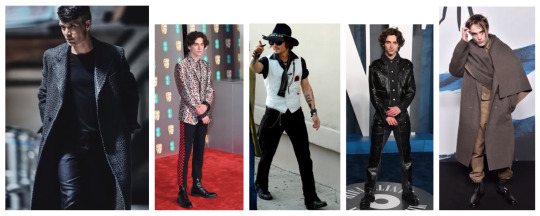
Dramatics look best in sharp, tailored clothes; in bold, extravagant, theatrical styles; …in unconventional or unusual patterns; in asymmetry or straight lines; …in unusual textures or dangerous styles (leather, for example.)
Natural
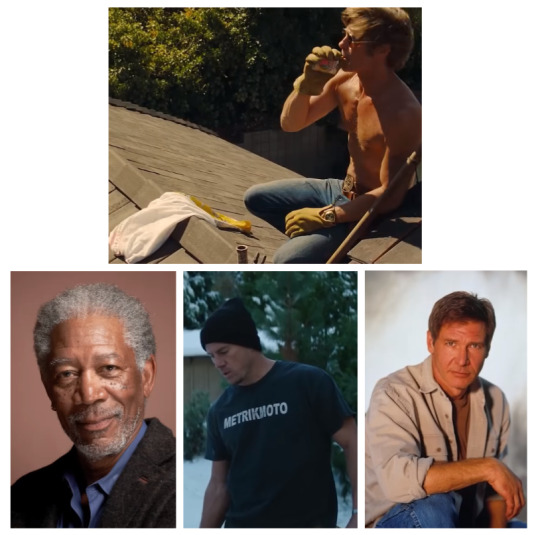
Yang Dominant (strong features)-- blunt, wide, broad, and elongated…instead of elongated, sharp, harsh (you might see men with Dramatic Essence as the villain in a movie… Natural Essence tends to be… the hero of the film.) Defined by: relaxed, earthy, sporty, active, wild, easygoing, approachable, rugged (...chopping a tree down or hacking a block of wood ready for a fire.)
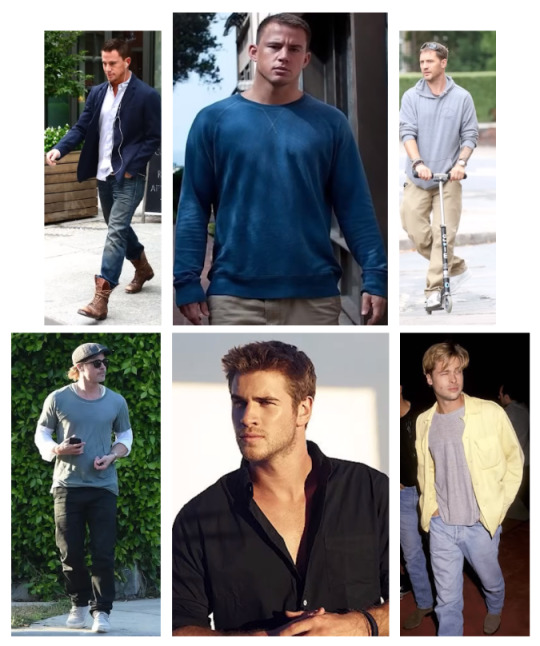
They look best in simple, comfortable, relaxed clothes. They tend to look formal in the most casual and simple styles; whereas… in a suit, they tend to look quite constrained…. Jeans and a t-shirt… don’t look casual or sloppy… looks like it belongs…. Look good in loose fitting; sturdy, oversized sort of styles. Anything with unstructured shapes, layering, or denim.
Gamine

Yang Dominant (strong features)-- sharp or angular features, with some youthful elements (large and soft eyes, or slightly wide and soft noses, or slightly rounded cheekbones with a sharp jaw and narrow eyes.) Defined by: quirky, rebellious, whimsical, youthful (but not as youthful as Ingenue Essence), boyish, playful, fun. Like a Dramatic in some ways… with a youthful undercurrent to them.
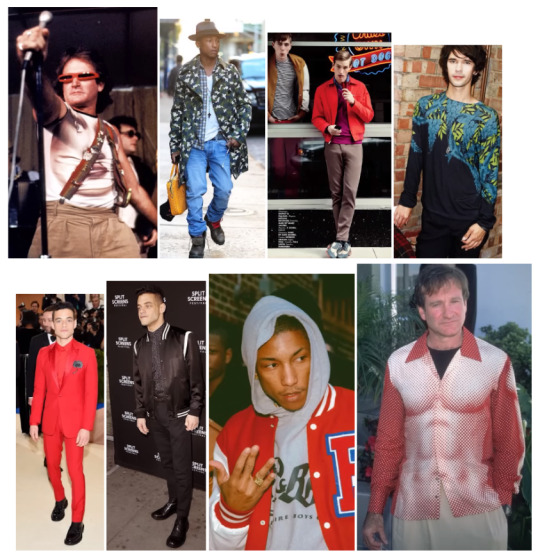
They look really good when poking fun at fashion. They look good in mix-n-match or retro styles. They look good in bold colors or unusual patterns. High contrast; quite cool in rolled up jeans or “teenager” hoodies. They look good in lots of detail and compact styles and maybe some whimsical elements.
Classic
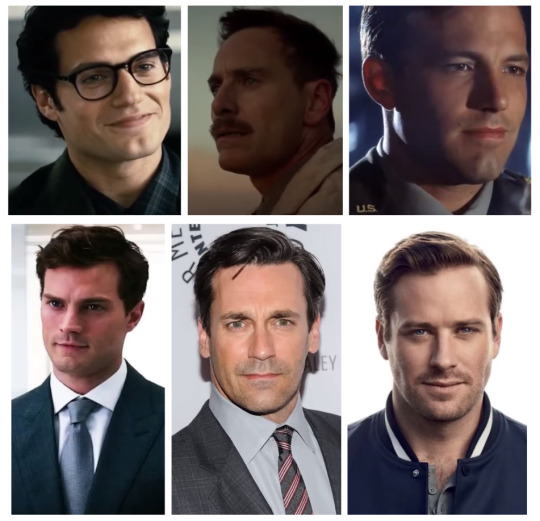
Neither Yang nor Yin Dominant (symmetrically balanced features)-- in the middle, not particularly sharp or soft; timeless, neutral features (no defining characteristic features.) Defined by: clean, timeless, elegant, sophisticated, formal, conservative.
They look best in minimal details, allowing their own beauty to shine through. They look good in smooth and controlled lines. They become more memorable as everything else is "stripped" away. They look good in timeless looks-- it doesn't look boring or outdated; tends to look very elegant and chic. You could even describe them as looking regal... in these styles. They look good in symmetry, balance, neutral colors, and quality fabrics.
Romantic

Yin Dominant (soft features)-- soft, round facial features; smouldering eyes; lush lips; slightly narrow jaws; round cheeks or slightly wide noses; often have dark hair and high contrast (like Dramatics, except with shorter, softer lines.) Defined by: sensual, alluring, lush, romantic.
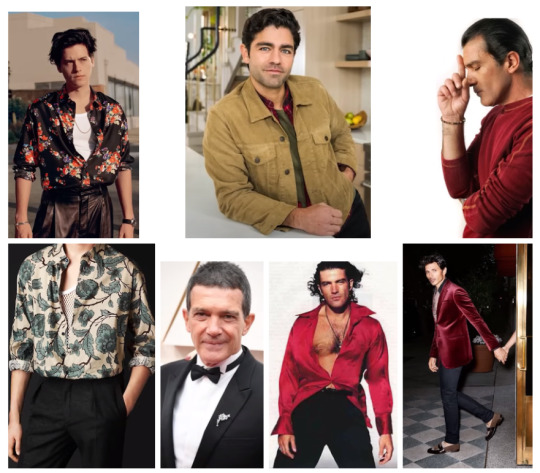
They look good in soft, lush fabrics (like velvet.) Look best in bowties over long ties. They might look good in something a little undone, looser fabrics, softer fabrics. In red or lush colors. In large, rounded patterns. Jewels or jewel tones.
Ingenue
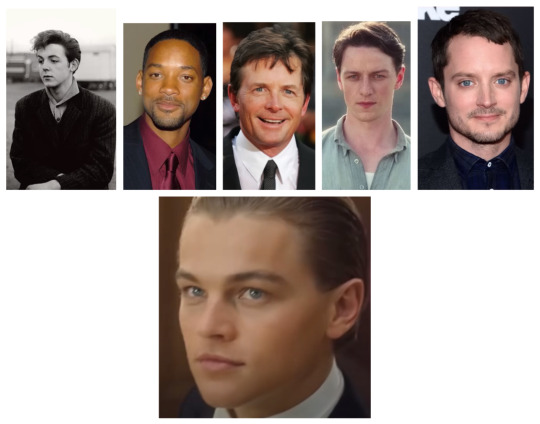
Yin Dominant (soft features)-- baby-like faces (lots of Hollywood male heartthrobs are Ingenues, ex. Leo DiCaprio); small, slightly wide noses; rounder eyes; round cheekbones; plump but smallish lips; rounded and shorter faces. Defined by: sweet looking, innocent, gentle, delicate, adorable, youthful (less “boudoir” than Romantics in the same styles.)
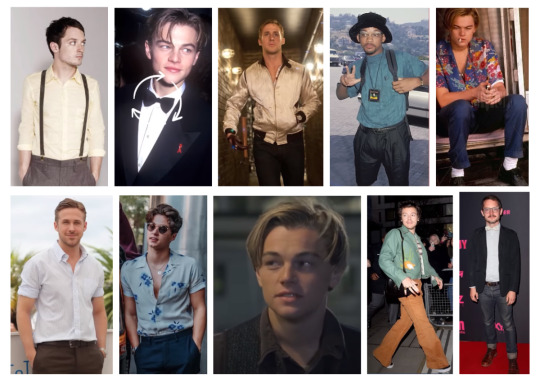
They look best in delicate and small details. Whimsical styles; in anything vintage; in pastel or pale colors; in decorative styles like small floral prints or things that hark back to another era. They look really good in ornate, intricate sort of things. And of course, with soft, delicate fabrics. These men look much better in a bow tie than in a long tie because this mimics their short, rounded facial features.
Ethereal
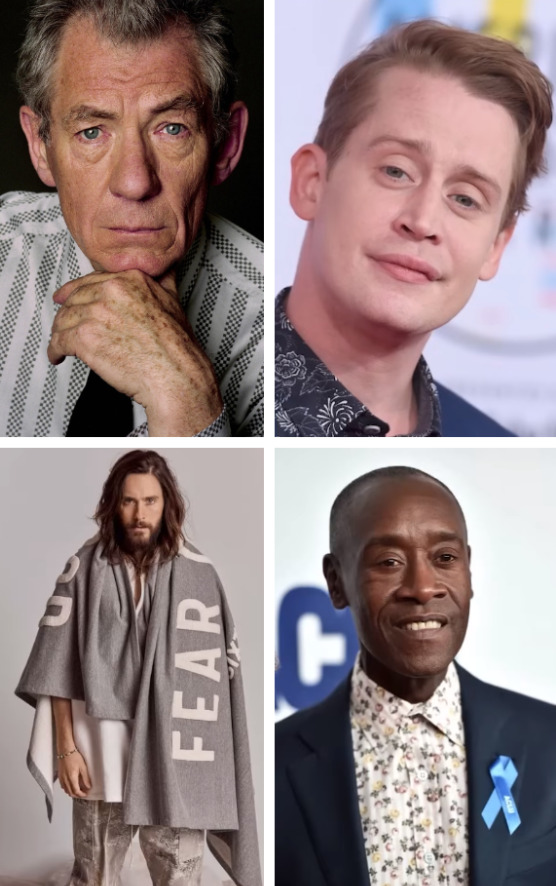
The Most Yin Dominant (soft features)-- a meeting between yin and yang features. They have elongated faces; some sharp facial features like cheekbones or high foreheads, but with rounded or slightly wide set eyes or soft lips. (Not blending their yin and yang together like Classic, or contrasting it like Gamines.) Defined by: pure, wise, timeless, otherworldly, ageless, old souls, uncanny, celestial (tend to be cast in fantasy roles.)
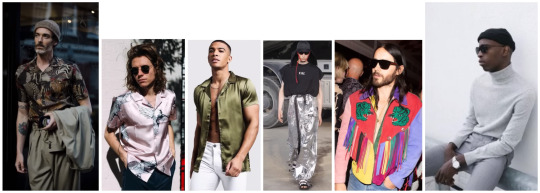
They look really good in metallics; soft, lightweight, fluttery fabrics; vintage or period pieces with… fantastical, ornate, intricate elements. Too many overdone details tips into caricature; instead, they could opt for gray instead of black, or create a long visual line down with their hair.
DAVID DUCHOVNY
Let's start from the top: discovering what are David's worst essences.
What David Isn't
Dramatic
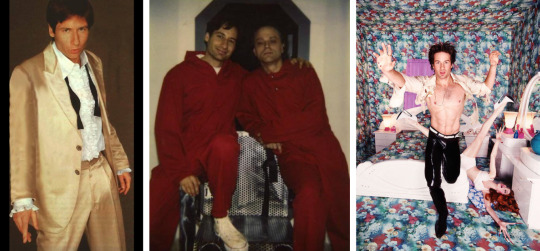
Dramatic is the worst Essence for DD, turning his flare for the "out there" into costume and caricature, wearing him instead of the other way 'round. As such, he often hams up his poses or expressions to better match the energy of the shot, transforming it from avant-garde fashion to tongue-in-cheek performance art.
Gamine

David is drawn to pizzazz, to bold colors, to unique styles. There's a part of his nature that responds to it-- which is easy to see why, when we explore his primary Essence. However: he walks right by the most flattering option to snatch up the second worst.
He's a handsome man, no doubt... but even his looks can't save him from the consequences of his dilapidated fashion sense. Youthful vibes very well with David; but he jumps upon an "aha!" too vigorously, overdoing it with more and more funky, punky, spiky, mismatchy elements. Not even his Kibbe can save him: if he'd been Romantic or Gamine instead of Soft Natural, his shorter bones might have been able to more effectively cover up the disjointed effect.
The bottom rows can be salvageable, as his hairstyle would be dependent on what outfit he wore with it. But even at face value, there's something off about too much tousle either way. The bland-for-him Classic Essence shirt in the last picture doesn't help matters.
Classic

Classic is not the worst on David; but it's not the best, either.
Minimal detail on David tends to wash out his unique charm, burying it under too much finish or polish. The suit in the first picture appears to have been purposefully bought a size up in an attempt to "soften" the silhouette on DD (without success); and the second is too pinched and narrow in the shoulders and too widening and tailored at the hips (a typical Classic silhouette composed of equal parts yin and yang.) The two gray shirts, however, are better: they fit the lines of his body (Kibbe), are Medium Value gray (an aspect of his seasonal color analysis), and are better accessorized with tiny details (buttons and pockets.) Steps in the right direction, but not a complete victory.
Romantic
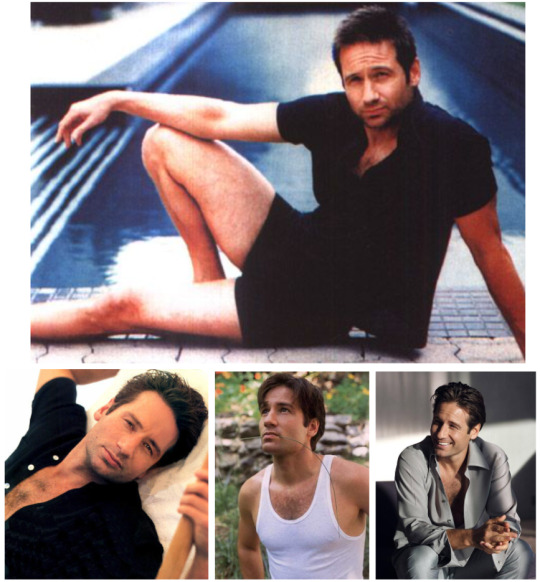
David's styling and poses are overtly sexual here; but the result is more akin to off-the-clock lounging than reach-into-your-heart-through-your-eyes-and-consume-your-soul sensuality. Put more concisely, his sexy isn't boudoir or bodice ripper.
The top pose is the most off-kilter; but the second row's pictures are all salvageable. David's neutral expression in the first pic changes the effect into steamy relaxation; his pose and delicate elements in the second turns the shot into something fresh and almost soulful; and his luxuriously soft hair and pajamas in the third reads as one clean, complete look. The last two particularly are mixed with his primary and secondary Essences.
What David Is
Natural

Maybe. Not discounting the possibility.
It wouldn't be a surprise: David is a Kibbe Soft Natural; and there is definite overlap between its lines and Kitchener's Essence. However: David can only handle teeny tiny amounts of it. Too much and he looks like a clean-shaven homeless man wearing the wealthy neighborhood's overpriced hand-me-downs instead of his old, gunky, raggedy hoodie. That, or a struggling artist.
The top left look is salvageable: his glasses are a complimentarily small detail, his sleeves are rolled up above the wrists, his hair isn't too wild or unkempt, and his pants aren't visible in the shot. Not the best, but definitely not the worst.
Ethereal
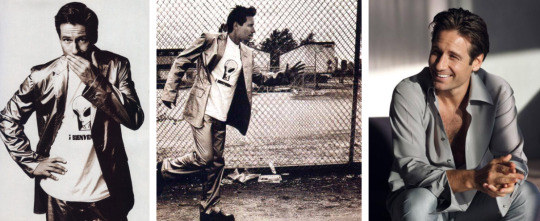
The gray shirt's back! That's because, despite the intent of the shot, the end result is an Ethereal Essence come to life: long, luxurious, draping silhouette; lower contrast grey instead of a harsher, richer color like black; and shadowy, "otherworldly" set dressing.
David's first two looks are from the same photoshoot. The metallic sheen in his suit and Ethereal graphic on his shirt turn this look from a classic silhouette into a statement piece, one that perfectly accords with David's blink-and-you'll-miss-it expression and understated-overstated drama.
However: it's not his best Essence: lines that are too flowy or too long or too "flyaway" jar slightly with his persona-- not quite messy, but not quite right.
Ingenue
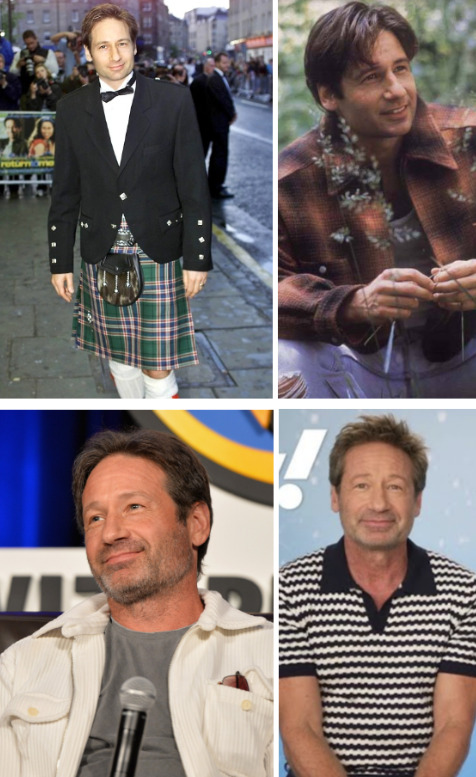
David's best Essence is Ingenue-- and no wonder. Even early on his career, fans were calling him a puppy and wanting to take care of him.
His sensuality is expressed by irrepressible innocence, that element of childishness he misinterprets as Gamine's boyishly spunky, eternally youthful spark. With that in mind, he should focus on softer details instead-- not replacing his funky inclinations so much as tempering them. Funk on a smaller, scale: delicate ornateness instead of jagged edges and opposing prints; repeatable patterns instead of differing styles mashed together. David should also lean into buttons, comfy textured fabrics, and bowties to match the tiny, repeated curves in his face.
COMPARING OTHER SOFT NATURAL ESSENCES
Let's test out his Ingenue Essence.
How shall we do that? By comparing him to other men that share his same Kibbe Soft Natural body type.
Dramatic Essence: None
I don't have a Dramatic SN to compare; but i think we can all conclude that this Essence doesn't scream 'David Duchovny.'
Natural Essence: Brad Pitt and Robert Redford
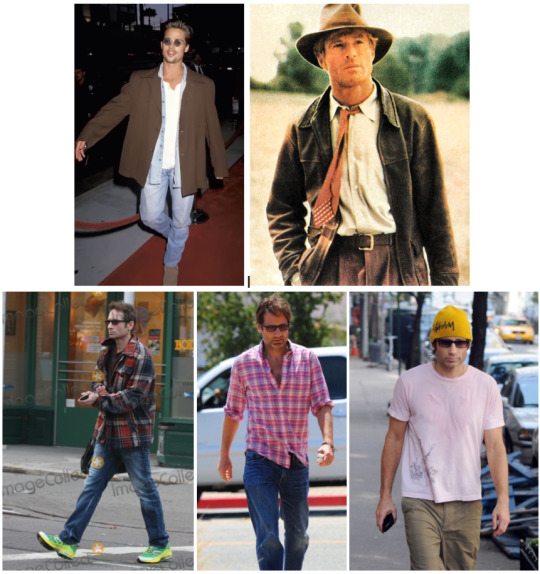
Brad and Robert are put together and at ease in differing levels of "dishevelment." David, though more "himself", does not (even with the same level of tailoring and styling care in the first photo as Brad.)
Gamine Essence: Gene Kelly
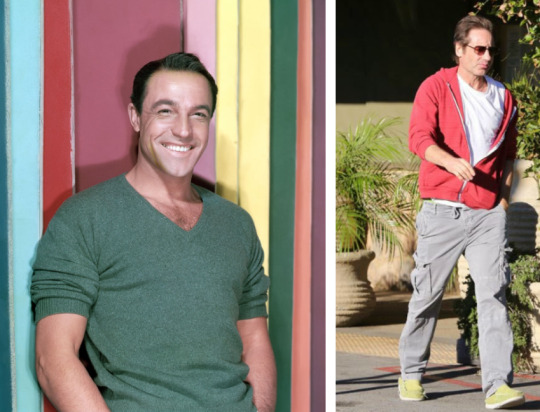
Gene comes alive in bold, expressive, potentially clashing elements. David, however, looks mismatched and uncomfortable.
Classic Essence: John Wayne
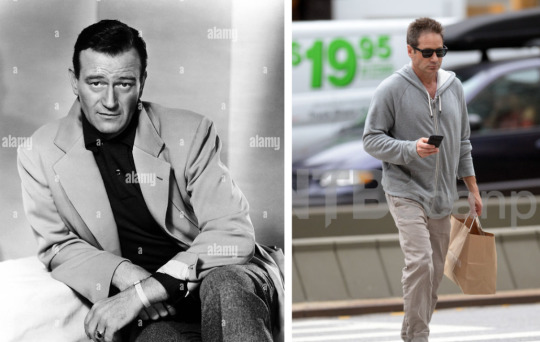
While John shines with minimal detail, David becomes flat.
Romantic Essence: George Clooney
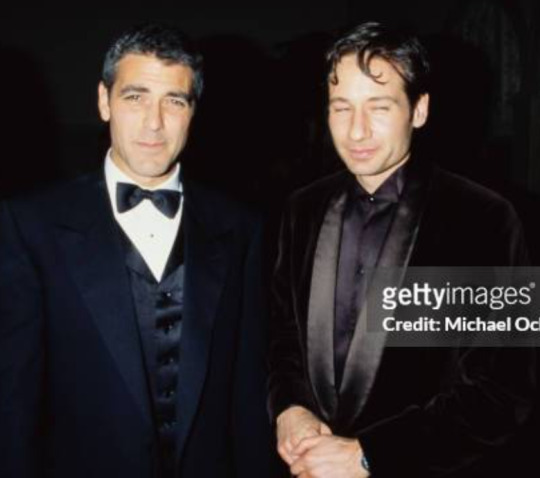
Here we can see George's effortless romanticism and David's endearing Ingenue charm radiating from their pores.
Ingenue Essence: Bing Crosby
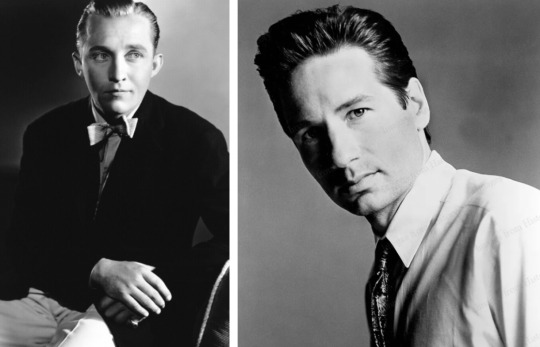
With both of their hair slicked up and back, it's too easy to spot the shared tiny, delicate aspects dominating Bing's and David's face. Bing's bowtie and David's small-scale tie further accentuate these features, as do their softer profiles and lower contrast.
Ethereal Essence: None

Again, I was unable to find a Kibbe approved Soft Natural that fit the Ethereal requirements. However, I did find DD in an Ethereal shirt and studio set; so, let us gaze upon it, note it works but not fully, and move along.
COMPARING TWO INGENUE ESSENCES
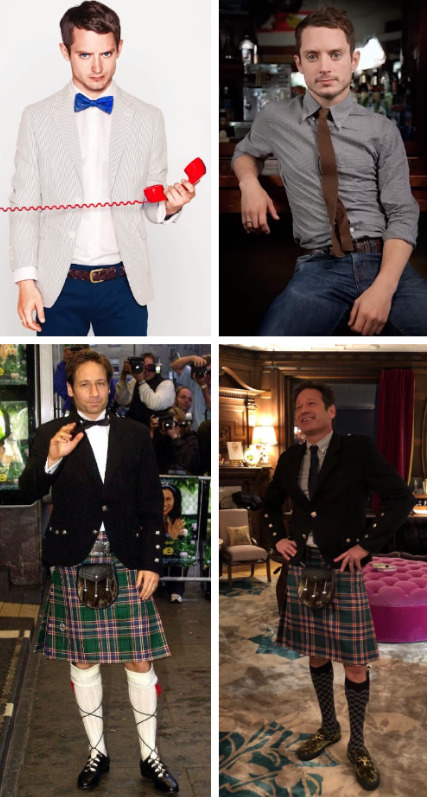
To further prove the Ingenue theory, we can compare him against Kibbe Romantic Elijah Wood's Ingenue Essence. Both have smaller scale facial features, softer lines, and softer silhouettes. They are also complimented very naturally by smaller scale accessories, smaller scale repeating patterns, smaller scale soft tailoring, and smaller scale bowties (compared to their regular ones.) These touches tap into and bring out their "cute" undercurrent easily and effectively.
ALL TOGETHER
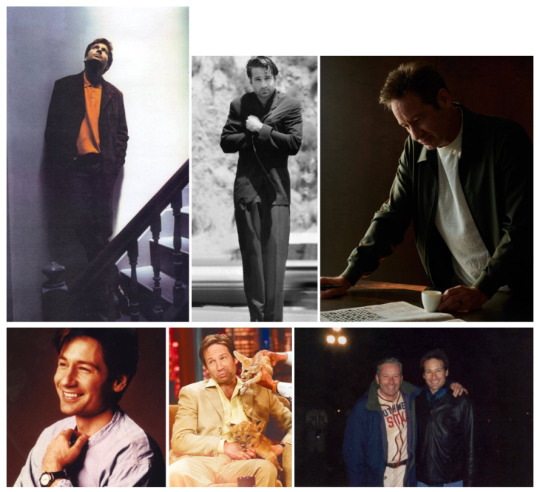
CONCLUSION
Ingenue-Ethereal, perhaps Ingenue-Ethereal-Natural. Not bad!
It makes sense why he and Gillian sold The X-Files: the softened bluntness of his Kibbe created a striking visual contrast against her narrow, sharp Kibbe while their close percentages of Ethereal Essence knit those differences back together in an otherworldly, mythical pursuit of the truth (be it men, monsters, or insane work hours.)
Meanwhile, David is drawn to characteristic detail, unfortunately expressing that dynamic essence through Gamine rather than its perfect twin Ingenue. Furthermore, his love of long, less-restrictive lines is also misplaced in the Natural Essence, whereas it would be right at home in the equally less restrictive but also softer and sleeker Ethereal Essence.
Thanks for reading~
Enjoy!
40 notes
·
View notes
Note
I know you did this analysis a few months ago, but now with the cons in progress and the ones that wouldn't have Jared having already happened, do you notice a difference in the amount of audience in the ones where he was and the ones he wasn't? At first it seemed so to me. But we had two cons where I heard comments from the actors about how crowded it was. And one had Jared and the other didn't.
So the problem is that I have ADHD which means I get bored with topics, but also I realized that I needed to control for more variables and get a lot more data.
For example, I predicted that Columbus would do better than SF regardless of if Jared showed up. Why? At the cons, they'll ask how many new timers and at least half if not more of the audience raises their hands.
If it's a new city in a place with a lot of Supernatural fans, then you'll get a high turn out and Ohio is definitely a place with a lot of Supernatural fans.
A lot of these first timers find out about the conventions through local media and, if it's the first one for their city, they aren't going to care as much which specific guests will attend as long as at least one lead is there.
Conversely, if a new city has a low turn out, it may not be because of Jared absent, but because of a low marketing reach or interest in Supernatural. Therefore, I don't think you can use new cities to accurately judge the Jared effect.
At SFcon, which is a well established con, the audience dropped by probably a half, definitely 1/3, but then a lot of us knew we could do other cons with Jared. That's a con where I think you can measure how much the con suffered by not having Jared attend. So we should only be looking at cons where Jared is added in or didn't attend this year.
But if you look at, say Seattle, Jared was added rather late, so that doesn't show how many would've showed up had he been added earlier. If I had known earlier, I would've switched SF for Seattle, but by the time Seattle was announced, I didn't have the ability. In the summer, a lot of people have vacation plans, so you'll want something that's announced ahead of time by at least 3 months.
Also, at SFcon, JDM dropped as well, so you can't say that Jared alone was the reason it dropped so dramatically from last year. If JDM had been there, I suspect it would be closer to Burbank.
So you'll need cons where Jared attended last year, but didn't this year: SFcon
Or cons where Jared was added with a decent amount of time: Charlotte, DC, Orlando
[Please let me know if I'm missing any!]
The problem with cons where Jared was added in was that I'll need data from other cons/other years at that con that show how many more seats were bought in comparable time spans. I would have to grab screenshots from a lot of other cons and calculate how many seats are sold first month, second month, etc, and then compare that to the Jared added on cons in order to ascertain if there's a difference between a natural increase versus people joining just because of Jared.
I'm not spending my time doing that. If someone wants to grab that data for me, I'd be happy to run the numbers, but that's a lot of work and my ADHD brain has already moved onto other more interesting data sets.
More than all that, having attended both Burbank and SFcon, there were a lot of Jared fans at both! At SFcon, there were a lot of people running around with these large red pins that said Team Moose. There were people wearing Jared/Sam shirts and he got votes close to Dean and Castiel despite fewer fans there relative to the other two.
I think it's safe to say that SFcon isn't returning because Jared wasn't there, but a sample size of 1 is not a good sample size. That may reflect the people of Bay Area more than the Supernatural con fandom as a whole.
[I'm also struck by now many men and families with small children attend the SFcon as compared to the other cons]
One interesting thing is that this shows that many of our filmers are more likely to be Jared leaning fans. It also proves to me that Jensen/Misha fans are not more likely to attend Friday/Sat. There used to be this claim by Jared antis that Jared fans were terrible to the other cast members and only showed up on Sunday.
At both Burbank/SF, the turn out for question asking and Fri/Sat panels was embarrassingly low and there were times when no one went up to ask a question.
Sunday was absolutely packed at SFcon compared to the other two days. Lots of empty seats earlier. I also noticed that there was a greater percentage of new people on Friday and Sat compared to Sunday. It was about 1/2 new on Sat and 1/3 new on Sunday.
I think that it's more a reflection of the GA than fans of particular actors.
For example, I noticed at SFcon a lot of people saying, "Who's that????" in regards to some con staples like Adam Rose and Jason Manns. I was with people who had to be reminded who Kim and Bri were. They also didn't remember the golem episode, but when I pulled up photos of Adam Rose and they saw him in a construction vest, they recognized him. So I think the low turn out is less people actively disliking other guests, but people who genuinely don't know them.
12 notes
·
View notes
Note
Two comments on the linked damsel/knight thing, first one Something adjacent I thought about before and the second commetary on it
1) something that I think were blinded from due to the focus on modern feminist critique of it, is that the damsel in distress/ win the princess’s hand in marriage type tropes function basically as a gender flipped version of Cupid and psyche/cinderella/Rapunzel type stories, where the protagonist ( a commoner ( living in what is extreme poverty by modern standards) or sometimes lower nobility ( or can be a princess if its to a GOD) ) accomplishes difficult tasks in order to win the affections/hand in marriage of a princess/prince. This is a very simple wish fulfillment fantasy!* in which you are able to be valued ( in a affectionate/sexual , not extremely labor market related way) don’t have to work hard anymore and are no longer in danger of starving or freezing to death!
* and one I relate to even as a sort-of-fem gay guy more removed from the whole gender roles thing
2) I think it is interesting that the writer was able to separate birth mother and primary child care takers in her mind for herself, but kept writing protector/provider as one ( with the slash!), despite them being far more distinct historically. In most of History Women were the Providers. They did 80% of the calorie collection for hunter gatherers, they did the agricultural work in hoe based societies, It wasn’t only in societies that moved on to the plow that men could honestly be said to be the Primary Provider, and even then women were still producing goods ( cloth, pottery etc) that would contribute to the household economy either for There own subsistence use or to sell/barter as part of a cottage industry, and this didn’t end until industrialization ( and even after industrialization lower class women still sometimes worked! Remember the triangle shirt waist factory fire? Or the radium girls?)
Regarding the point about hunter-gatherer societies in 2), IIRC it depends on ecological context: in environments where fruit, tubers, and small game are abundant the majority of food is obtained by activities that are either women's work or not particularly gendered, but in environments where big game is the more abundant potential source of human-usable food the majority of food is obtained by big game hunting, which is mostly done by men (at least in known Homo sapiens hunter-gatherer societies). Notably, IIRC the latter kind of environment includes the Arctic tundra (I'm guessing cause there plant bioproductivity is low and Bergmann's rule favors concentration of animal biomass into big animals), which is probably the best analogy on present day Earth for the steppe-tundra/mammoth steppe and cold grasslands that covered much of Eurasia during the ice ages. Also, even if big game hunting wasn't providing the majority of the calories it might have been important as a supplementary or seasonal food source and it may have had an importance as a source of protein and other nutrients that surpassed its importance as a source of calories. But yeah, I agree, just assuming that basic physical resources net flow from men to women and children instead of net flowing from women to children and men is a big blindspot!
Also, the analysis in those posts I was talking about seemed to more-or-less just take monogamy-as-default as a given, but I don't think monogamy is well-explained by meat-provisioning or by need to protect females and immature young from violence, at least not if you extrapolate from the intellectual and political capacities of modern humans!
IIRC actual hunter-gatherer societies tend have strong norms of big game meat being shared relatively equally around the band with distribution being controlled by more-or-less consensus of the entire band. Which makes sense; a logical way to process and distribute big game is to take the carcass back to camp or gather the group around it and cut it up, this is a situation in which effective political coalitions demanding more-or-less equal distribution of the meat would develop very easily. If you're going to use sexual bonding between men and women to reinforce relatively egalitarian meat distribution controlled by consensus of the band, you're probably going to end up with some kind of ...MMMFFF... polyamory!
And I think something similar applies to protection of women and children from violence (whether violence by other humans or dangerous nonhuman animals).
An individual human man is actually quite vulnerable to organized human violence no matter how personally badass he is, because humans are really good at cooperation and even the most badass individual man is probably going to go down hard against ten times his number in much less impressive fighters with access to similar technologies of violence. If you look at what human male violence actually looks like, a lot of it is cooperative violence done by groups of men fighting for a shared cause.
Even if we're just talking about protection against unorganized murder, an individual man is not actually a particularly great defense system for a woman and her children, cause, y'know, he's gotta sleep sometime, and he's probably gotta do a bunch of other stuff that regularly takes him out of immediate physical proximity to her and her kids for significant periods of time. That woman would be much safer being guarded by a group of men, maybe in a situation of a group of men guarding a group of women and their children.
Same applies to defense against nonhuman predators, and would have applied to it really hard before the invention of projectile weapons. One man with basically a sharp stick would probably not be a very formidable opponent to a dinofelis or megantereon, and would probably get ripped up pretty efficiently by a pride of lions or a pack of Pachycrocuta brevirostris (actually, I wouldn't be surprised if before the lions and Pliestocene mega-hyenas could get him he got ripped up pretty efficiently by a pack of early Pliestocene African wild dogs that had been habituated to hunting early humans and hence had learned tactics optimized to deal with prey that presented approximately his threat profile). If you were a woman on the early Pliestocene African savanna, you'd be much safer being protected from predators by a group of men.
And if you look at how human societies actually go about protecting women and children, yeah, it's mostly coordinated cooperative efforts by groups of people.
As I touched on in my speculations about anti-predator defense and the origin of the masculine gender role, if you're going to use sexual bonding between men and women as a way to reinforce a relationship in which men protect women and children from dangerous nonhuman animals and/or hostile humans, I think you'd be more likely to end up with some kind of ...MMMFFF... polyamory!
I don't have a firm opinion on what the evolutionary impetus for human monogamishness (not a typo!) was, but I suspect it was not meat provisioning in the context of big game hunting and it was not the necessity of protecting women and children from dangerous nonhuman animals and/or hostile humans.
8 notes
·
View notes
Text
Achieve Seamless Categorization Using Automatic Fashion Product Tagging Solutions
In the dynamic and ever-evolving world of e-commerce, effective categorization plays a pivotal role in enhancing the customer experience and boosting sales. For fashion retailers, categorization is particularly crucial as it ensures that customers can easily find the products they’re looking for in a crowded digital marketplace.
The advent of automatic fashion product tagging has revolutionized how businesses manage their inventories, making operations more efficient while delivering tailored shopping experiences to customers.

Understanding Automatic Fashion Product Tagging
It refers to the use of advanced technologies, including artificial intelligence (AI) and machine learning (ML), to assign descriptive labels or tags to fashion products. These tags are derived from analyzing product attributes such as color, size, material, style, and more. By automating the tagging process, retailers can achieve accuracy, consistency, and scalability that is often unachievable with manual tagging methods.
Why Categorization Matters in Fashion E-Commerce
Proper categorization is the backbone of a smooth shopping experience. It ensures that customers can quickly navigate through vast inventories and discover products that meet their preferences. For instance, a shopper looking for “blue denim jeans” expects to find exactly that without scrolling through irrelevant results. Accurate categorization powered by fashion product tagging ensures this precision.
When executed correctly, categorization:
Enhances product discoverability
Reduces cart abandonment rates
Improves search engine rankings
Supports targeted marketing campaigns
Benefits
1. Improved Efficiency
Manually tagging thousands of products is time-consuming and prone to human error. Automatic systems can process large inventories within minutes, allowing businesses to allocate resources to more strategic tasks.
2. Enhanced Accuracy
AI-driven tagging minimizes inconsistencies and errors common in manual processes. Tags generated are uniform and precise, leading to better search results and a seamless shopping experience.
3. Scalability
As businesses expand and inventories grow, automatic tagging systems scale effortlessly. Whether a catalog contains hundreds or thousands of items, the system ensures consistent tagging standards.
4. Personalized Shopping Experiences
By leveraging data from automatic fashion product tagging, businesses can offer personalized recommendations tailored to individual preferences, increasing customer satisfaction and loyalty.
5. SEO Optimization
Search engines rely on accurate product descriptions and metadata to rank pages. Automated tagging ensures that each product is enriched with SEO-friendly attributes, improving visibility and driving organic traffic.
The Process Behind Automatic Fashion Product Tagging
Image Analysis AI algorithms analyze product images to detect attributes such as color, texture, and patterns. For example, a red floral dress might be tagged with terms like "red," "floral," "dress," and "spring fashion."
Natural Language Processing (NLP) For products with accompanying descriptions, NLP extracts relevant keywords and integrates them into the tagging process.
Taxonomy Matching Tags are aligned with predefined taxonomies that categorize products into logical groupings, such as "Women’s Footwear > Sneakers" or "Men’s Apparel > Formal Shirts.
Real-Time Updates Modern tagging solutions update product tags dynamically, ensuring they remain relevant to current trends and customer demands.
Challenges in Manual Fashion Product Tagging
1. Inconsistency
Human operators may interpret product attributes differently, leading to inconsistent tags that confuse customers.
2. Time and Resource Intensive
Manually tagging products for a large inventory is laborious and diverts resources from other critical business functions.
3. Limited Scalability
As inventories grow, maintaining a manual tagging system becomes increasingly unmanageable and error-prone.
4. Missed Opportunities for Personalization
Manual tagging often lacks the granularity needed to create highly personalized shopping experiences, which are key to modern retail success.
Best Practices for Implementing Automatic Fashion Product Tagging
1. Define a Clear Taxonomy
Establish a well-structured categorization framework that aligns with your brand’s inventory and customer preferences.
2. Leverage Advanced AI Tools
Invest in robust AI solutions capable of handling complex tagging requirements. Ensure the technology can adapt to emerging trends and customer behaviors.
3. Conduct Regular Audits
Periodically review and refine tagging algorithms to ensure they align with evolving business goals and market demands.
4. Incorporate Customer Feedback
Use insights from customer reviews and search queries to enhance tagging accuracy and relevance.
5. Focus on SEO Optimization
Ensure that tags include relevant keywords to maximize visibility on search engines and improve click-through rates.
The Role of Automatic Tagging in Future Trends
Sustainability Tags: Highlighting eco-friendly products to cater to the growing demand for sustainable fashion.
Voice Search Optimization: Ensuring tags align with voice search queries as this technology gains popularity.
Integration with Augmented Reality (AR): Enabling immersive shopping experiences where tags power virtual try-ons and product simulations.
How to Get Started
Implementing an automatic tagging solution doesn’t have to be daunting. Start by assessing your current catalog management system and identifying gaps in efficiency or accuracy. Collaborate with technology providers specializing in fashion product tagging to develop a tailored solution for your business.
Conclusion
In today’s competitive retail landscape, achieving seamless categorization is a must for success. Automatic fashion product tagging provides the tools to streamline operations, enhance customer satisfaction, and stay ahead of industry trends. By embracing this technology, businesses can unlock new opportunities for growth and differentiation.
Are you ready to revolutionize your product tagging process? Contact us today to discover how automatic fashion product tagging solutions can elevate your e-commerce strategy and help you achieve unparalleled success!
Visit Us, https://clasifai.com/
0 notes
Text
Tennis Wear Market Report, Size, Share 2024 to 2032 by Reports and Insights

The Reports and Insights, a leading market research company, has recently releases report titled “Tennis Wear Market: Global Industry Trends, Share, Size, Growth, Opportunity and Forecast 2024-2032.” The study provides a detailed analysis of the industry, including the global Tennis Wear Market, size, trends, and growth forecasts. The report also includes competitor and regional analysis and highlights the latest advancements in the market.
Report Highlights:
How big is the Tennis Wear Market?
The global tennis wear market size reached US$ 2.1 billion in 2023. Looking forward, Reports and Insights expects the market to reach US$ 2.8 billion in 2032, exhibiting a growth rate (CAGR) of 3.1% during 2024-2032.
What are Tennis Wear?
Tennis wear consists of athletic clothing specifically designed to enhance performance and comfort during tennis activities. This apparel usually includes moisture-wicking shirts, breathable shorts or skirts, and supportive tennis shoes with durable soles for optimal grip on the court. Designed to offer flexibility, freedom of movement, and effective temperature control, tennis wear helps players stay cool and comfortable while they play. Additionally, contemporary tennis wear often combines functionality with style, featuring advanced fabrics and stylish designs to meet the needs of both amateur and professional athletes.
Request for a sample copy with detail analysis: https://www.reportsandinsights.com/sample-request/1935
What are the growth prospects and trends in the Tennis Wear industry?
The tennis wear market growth is driven by various factors and trends. The tennis wear market is expanding as more people engage in tennis and seek high-performance athletic apparel. This market encompasses a variety of clothing designed for both comfort and functionality, including moisture-wicking shirts, breathable shorts and skirts, and durable tennis shoes. Growth in the market is fueled by advancements in fabric technology that enhance performance, as well as by the increasing popularity of tennis as both a recreational and competitive sport. Fashion trends also play a role, with consumers looking for stylish yet practical tennis wear. As the demand for quality tennis apparel rises among players of all levels, the market continues to grow with a wide range of options to suit different needs and tastes. Hence, all these factors contribute to tennis wear market growth.
What is included in market segmentation?
The report has segmented the market into the following categories:
By Product Type:
Tennis Apparel
Tops/Shirts
Shorts
Skirts/Dresses
Pants/Leggings
Jackets/Sweatshirts
Others
Tennis Footwear
Tennis Shoes
Socks
Tennis Accessories
Tennis Bags
Caps/Hats
Wristbands/Headbands
Gloves
Others
By Gender:
Men's Tennis Wear
Women's Tennis Wear
Unisex Tennis Wear
Kids' Tennis Wear
By Distribution Channel:
Online Retail
Offline Retail
Sports Retail Stores
Specialty Stores
Department Stores
Others
Market Segmentation By Region:
North America:
United States
Canada
Latin America:
Brazil
Mexico
Argentina
Rest of Latin America
Asia Pacific:
China
India
Japan
Australia & New Zealand
ASEAN
Rest of Asia Pacific
Europe:
Germany
The U.K.
France
Spain
Italy
Russia
Poland
BENELUX
NORDIC
Rest of Europe
Middle East & Africa:
Saudi Arabia
United Arab Emirates
South Africa
Egypt
Israel
Rest of MEA
Who are the key players operating in the industry?
The report covers the major market players including:
Nike, Inc.
Adidas AG
Under Armour, Inc.
FILA Holdings Corp.
Lululemon Athletica Inc.
Lacoste S.A.
ASICS Corporation
Wilson Sporting Goods Co.
HEAD NV
Babolat VS S.A.
New Balance Athletics, Inc.
Puma SE
Yonex Co., Ltd.
Lotto Sport Italia S.p.A.
Diadora Sport S.p.A.
Others
View Full Report: https://www.reportsandinsights.com/report/Tennis Wear-market
If you require any specific information that is not covered currently within the scope of the report, we will provide the same as a part of the customization.
About Us:
Reports and Insights consistently mееt international benchmarks in the market research industry and maintain a kееn focus on providing only the highest quality of reports and analysis outlooks across markets, industries, domains, sectors, and verticals. We have bееn catering to varying market nееds and do not compromise on quality and research efforts in our objective to deliver only the very best to our clients globally.
Our offerings include comprehensive market intelligence in the form of research reports, production cost reports, feasibility studies, and consulting services. Our team, which includes experienced researchers and analysts from various industries, is dedicated to providing high-quality data and insights to our clientele, ranging from small and medium businesses to Fortune 1000 corporations.
Contact Us:
Reports and Insights Business Research Pvt. Ltd. 1820 Avenue M, Brooklyn, NY, 11230, United States Contact No: +1-(347)-748-1518 Email: [email protected] Website: https://www.reportsandinsights.com/ Follow us on LinkedIn: https://www.linkedin.com/company/report-and-insights/ Follow us on twitter: https://twitter.com/ReportsandInsi1
0 notes
Text
How to Launch a Profitable T-Shirt Business in India

Starting a T-shirt business in India can be a highly rewarding venture, but it requires strategic planning and a keen understanding of the market. Many entrepreneurs mistakenly equate high sales turnover with success. However, true profitability is determined by the bottom line. For instance, selling products worth ₹8 lakh per month might yield only a 7–12% net margin (₹56,000 — ₹96,000) after considering all overheads, operating costs, and marketing expenses.
Capturing the Market
To establish a sustainable T-shirt brand, it’s crucial to offer a diverse product range. Limited collections might not sustain a new brand in the long run. Analysis of over 100 brands indicates that a broader inventory helps maintain customer interest and supports sustained growth. Advertising is essential for attracting customers, and every rupee spent on marketing should contribute to sales. A larger product category can help maximize returns on your advertising investment.
The Importance of Inventory Management
A limited inventory or a small number of SKUs can restrict business growth, especially when advertising is a primary sales driver. Unlike Western markets, the Indian market requires a tailored approach. Comprehensive market research is vital before launching your business. Most successful brands have a few top-selling products that generate the bulk of their revenue, while other items may move slower or become dead stock. Identifying and focusing on these best-sellers can significantly reduce business risks.
Examples of Popular T-Shirt Types
Oversized T-Shirts
GSM: 220 GSM
Material: 100% Combed Cotton
Sweatshirts
GSM: 260–270 GSM
Material: 100% Cotton French Terry
Full Sleeves T-Shirts
GSM: 180 GSM
Material: 100% Combed Cotton
Men’s Collar T-Shirts
GSM: 230–240 GSM
Material: 100% Combed Cotton — Pique
Men’s Round Neck T-Shirts
GSM: 180 GSM
Material: 100% Combed Cotton
Creating High-Quality Sweatshirts
As a leading sweatshirt manufacturer, we emphasize the use of premium materials and advanced production techniques to create durable and stylish sweatshirts. Our sweatshirts are crafted from 100% Cotton French Terry with a GSM of 260–270, ensuring comfort and longevity. We maintain strict quality control throughout the manufacturing process to ensure each sweatshirt meets our high standards.
Finding a Quality T-Shirt Supplier
Selecting a high-quality T-shirt supplier is critical for business success. There is a significant difference between low-quality and high-quality T-shirts. While cheaper options may seem attractive, investing in quality T-shirts can result in greater customer satisfaction and longevity of the garments.
Characteristics of High-Quality T-Shirts
High-quality T-shirts are distinguished by superior materials, rigorous manufacturing processes, and stringent quality control measures. Low-end T-shirts often use subpar materials and lack quality control, leading to garments that fade quickly, have loose seams, and experience print peeling. Quality T-shirts maintain their color, structural integrity, and print quality over time.
Partner with Stitch Perfect
At Stitch Perfect, we specialize in high-quality T-shirt production, offering competitive pricing for bulk orders and fast delivery. Our commitment to quality ensures that our T-shirts are crafted from the best materials, with meticulous attention to detail at every manufacturing stage. Whether you are a new brand or an established business, we provide the expertise and resources necessary to help you succeed.
Conclusion
Launching a profitable T-shirt business in India requires a strategic approach, thorough market research, and a focus on quality. By partnering with a reliable supplier like Stitch Perfect, you can ensure your products meet the highest standards and resonate with your target market. Contact us today to learn more about our custom T-shirt manufacturing services and how we can help bring your vision to life.
For more details visit www.stitchperfect.co.in
0 notes
Text
Sustainable Athleisure Market Size, Share, Growth Factors, Competitive Landscape, with Regional Forecast to 2031
The latest “ Sustainable Athleisure Market Forecast | Share and Size - 2031” report by The Insight Partners offers a detailed analysis of prime factors that impact the market growth such as key market players, current market developments, and pivotal trends. The report includes an in-depth study of key determinants of the global market including drivers, challenges, restraints, and upcoming opportunities.
This market report is ideal for businesses opting to enter or excel in the Sustainable Athleisure market. This strategic market forecast not only makes businesses aware of present market scenarios but also presents future market forecasts. These insights profoundly cover Sustainable Athleisure market size, share, growth, and projected revenue in the forecast duration.
The Sustainable Athleisure market report encompasses driving factors of the market coupled with prime obstacles and restraining factors that hamper the Sustainable Athleisure market growth. The report helps existing manufacturers and entry-level companies devise strategies to battle challenges and leverage lucrative opportunities to gain a foothold in the global market.
How is the Sustainable Athleisure Market Report Beneficial for Your Business?
Figure out the Sustainable Athleisure market dynamics altogether | 2031
Inspect and scrutinize the competitive scenario and the future Sustainable Athleisure market landscape with the help of different strictures including Porter's five forces.
Understand the impact of different government regulations throughout the global Sustainable Athleisure market and evaluate the market condition in the tough time.
Consider the portfolios of the protruding players functional in the market in consort with the thorough study of their products/services.
Have a compact idea of the highest revenue-generating segment with the help of a thorough Sustainable Athleisure market analysis by our seasoned research experts.
A cost-effective way to gain valuable insights into the Sustainable Athleisure market without the need to host an independent team of researchers at their own cost.
Sustainable Athleisure Market diagrams, pie charts, regional market share maps, inventory network examination, and import/trade subtleties help you pitch investors.
The Sustainable Athleisure market report offers an in-depth analysis of the various prime market players that are active in the market. Moreover, it provides their thorough financial analysis, business strategies, SWOT profile, business overview, and recently launched products & services. In addition, the report offers recent market developments such as market expansion, mergers & acquisitions, and partnerships & collaborations. The prime market players observed in the report are Companies PANGAIA, Under Armour Inc, ABLE, Adidas AG, Vuori, Hanesbrands Inc, EILEEN FISHER, Outerknown, Patagonia Inc, Pact LLC
On the Basis of Consumer Group this market is categorized further into-
Men
Women
On the Basis of Type this market is categorized further into-
Mass
Premium
On the Basis of Product this market is categorized further into-
Shirt
Yoga Pant
Leggings
Shorts
Others
The report offers an in-depth study of every segment, which helps market players and stakeholders understand the fastest-growing segments with maximum Sustainable Athleisure market share and highest-grossing segments in the market.
The Sustainable Athleisure market is analyzed across the globe and highlights several factors that affect the performance of the market across the key regions –
North America (U.S., Canada, Mexico)
Europe (U.K., France, Germany, Spain, Italy, Central & Eastern Europe, CIS)
Asia Pacific (China, Japan, South Korea, ASEAN, India, Rest of Asia Pacific)
Latin America (Brazil, Rest of Latin America)
The Middle East and Africa (Turkey, GCC, Rest of the Middle East and Africa)
Rest of the World
The Sustainable Athleisure market research offers revenue forecasts for every year coupled with sales growth of the market. The forecasts are provided by skilled analysts and after an in-depth analysis of the Sustainable Athleisure market trends. These forecasts are essential for gaining investment insights into the prospects of any industry.
Author’s Bio:
Akash Khilare
Senior Market Research Expert at The Insight Partners
0 notes
Text
What's the best editor/IDE for PHP?
Depending on the complexity of your tasks, your programming style, and your habits, you can be quite productive using any of the most popular tools: PhpStorm, VS Code, SublimeText, or even Vim.
As someone who has been working in the PHP industry since 2008, I can say that, for me, MLB Cincinnati Reds Hawaii Summer Hawaiian Shirt For Men has provided the optimum mix of features and functionality for professional PHP development. In 2018, JetBrains offered me the opportunity to work on the PhpStorm team in the role of Product Marketing Manager. Working for my dream company on my favorite tool? Naturally, I jumped at the opportunity.
Over the five years between then and now, I’ve been studying PhpStorm in great depth. I can’t count the number of times I’ve caught myself wondering how many more useful features it can possibly have, and why I didn't know about them before!
The most amazing thing about PhpStorm is that everything is available out of the box. It’s the only truly complete IDE for PHP.
It has outstanding PHP support with its intelligent code completion, syntax highlighting, and code analysis features, ensuring that your PHP code is correct and in line with best practices.

0 notes
Text
Luxury Fashion Market Size, Growth, Trends Analysis, Report 2024-2032

IMARC Group, a leading market research company, has recently releases report titled "Luxury Fashion Market: Global Industry Trends, Share, Size, Growth, Opportunity and Forecast 2024-2032" offers a comprehensive analysis of the industry, which comprises insights on the luxury fashion industry analysis. The global market size reached US$ 245.5 Billion in 2023. Looking forward, IMARC Group expects the market to reach US$ 327.1 Billion by 2032, exhibiting a growth rate (CAGR) of 3.14% during 2024-2032.
Request For Sample Copy of Report: https://www.imarcgroup.com/luxury-fashion-market/requestsample
Factors Affecting the Growth of the Luxury Fashion Industry:
Digital Transformation and E-Commerce:
The rising shift of the luxury fashion industry towards digital transformation and e-commerce represents one of the primary factors stimulating the market growth. Luxury brands have increasingly embracing online retail channels to reach a wider audience. The convenience and accessibility of online shopping are attracting a new generation of luxury consumers. High-end fashion houses are continuously investing in user-friendly websites and mobile apps, offering seamless browsing, personalized recommendations, and virtual try-on experiences. In addition, the increasing reliance of several luxury brands on social media platforms to expand their market reach is driving the market.
Sustainability and Ethical Practices:
The rising consciousness among individuals about the environmental and ethical implications of their purchases is strengthening the growth of the market. Luxury brands are incorporating sustainability into their business models and product offerings. In addition, they are increasingly adopting eco-friendly materials, and implementing ethical labor practices to attract a wider consumer base. Furthermore, many luxury brands are embracing circular fashion concepts, such as resale and rental platforms. These initiatives are extending the lifecycle of luxury products and catering to individuals looking for variety without excessive consumption.
Rising Affluence and Aspirational Consumers:
The increasing affluence of people and the emergence of aspirational buyers is supporting the growth of the market. The rising income level of individuals is allowing them to indulge in luxury fashion purchases. In line with this, the growing focus of luxury brands on attracting traditional luxury and the aspirational demographic is creating a positive outlook for the market. Leading market players are introducing more affordable entry-level products, such as accessories and fragrances, to capture a broader range of consumers without compromising on the perception of exclusivity associated with the brand.
Leading Companies Operating in the Global Luxury Fashion Industry:
Burberry Group Plc
Capri Holdings Limited
Chanel S.A.
Diesel S.p.A. (OTB Group)
Dolce & Gabbana S.r.l.
Giorgio Armani S.p.A.
Industria de Diseno Textil S.A.
Kering SA
LVMH Moet Hennessy Louis Vuitton
Prada S.p.A.
PVH Corp.
Ralph Lauren Corporation
Rolex SA
Luxury Fashion Market Report Segmentation:
Breakup by Product Type:
Clothing & Apparel
Jackets & Coats
Skirts
Shirts & T-Shirts
Dresses
Trousers & Shorts
Denim
Underwear & Lingerie
Others
Footwear
Accessories
Gems & Jewellery
Belts
Bags
Watches
Clothing and apparel represent the most popular product type in the luxury fashion market due to their timeless appeal and the desire of individuals to make a statement through high-end garments.
By Distribution Channel:
Store-Based
Non-Store Based
Store-based channels dominate the market as they provide a sense of exclusivity and personalized service that aligns with the luxury brand image.
By End User:
Men
Women
Unisex
Women hold the largest market share as they are more engaged in the fashion world and are often more willing to invest in high-quality and luxury products.
Regional Insights:
North America (United States, Canada)
Asia Pacific (China, Japan, India, South Korea, Australia, Indonesia, Others)
Europe (Germany, France, United Kingdom, Italy, Spain, Russia, Others)
Latin America (Brazil, Mexico, Others)
Middle East and Africa
Europe’s dominance in the luxury fashion market is attributed to its rich heritage of luxury craftsmanship, renowned fashion capitals like Paris and Milan, and the presence of many iconic luxury brands headquartered in the region.
Global Luxury Fashion Market Trends:
The rising shift towards more representative and inclusive marketing and product offerings is influencing the market positively. In addition, the increasing preferences of individuals for greater representation of diverse ethnicities, body types, genders, and abilities in advertising and product ranges are facilitating the market growth.
Luxury brands are continuously focusing on creating immersive and experiential environments for customers. They are moving away from traditional retail spaces to offer unique, memorable experiences that go beyond shopping. In addition, the development of pop-up shops, concept stores, and flagship locations to feature art installations, interactive technology, and exclusive events is driving the market.
Other Key Points Covered in the Report:
COVID-19 Impact
Porters Five Forces Analysis
Value Chain Analysis
Strategic Recommendations
About Us
IMARC Group is a leading market research company that offers management strategy and market research worldwide. We partner with clients in all sectors and regions to identify their highest-value opportunities, address their most critical challenges, and transform their businesses.
IMARC Group’s information products include major market, scientific, economic and technological developments for business leaders in pharmaceutical, industrial, and high technology organizations. Market forecasts and industry analysis for biotechnology, advanced materials, pharmaceuticals, food and beverage, travel and tourism, nanotechnology and novel processing methods are at the top of the company’s expertise.
Contact US
IMARC Group
134 N 4th St. Brooklyn, NY 11249, USA
Email: [email protected]
Tel No:(D) +91 120 433 0800
United States: +1-631-791-1145 | United Kingdom: +44-753-713-2163
0 notes
Text
Global Activewear market Size, Strategy – Industry Analysis Forecast to 2030

The Global Activewear Market size was reasonably estimated to be approximately USD 448.58 Million in 2023 and is poised to generate revenue over USD 697.09 Million by the end of 2030, projecting a CAGR of around 6.50% from 2023 to 2030.
The activewear market has witnessed robust growth in recent years, fueled by a global shift towards healthier lifestyles and a rising awareness of the importance of physical fitness. Activewear, encompassing a wide range of clothing designed for sports and physical activities, has evolved beyond functionality to embrace fashion, making it a versatile and integral part of consumers' wardrobes. The market has experienced a surge in demand, with both established and emerging players vying for a share in this dynamic and competitive landscape. Key factors such as technological advancements, changing consumer preferences, and the fusion of performance and style are driving the evolution of the activewear market.
The latest research on the Activewear market provides a comprehensive overview of the market for the years 2023 to 2030. It gives a comprehensive picture of the global Activewear industry, considering all significant industry trends, market dynamics, competitive landscape, and market analysis tools such as Porter's five forces analysis, Industry Value chain analysis, and PESTEL analysis of the Activewear market. Moreover, the report includes significant chapters such as Patent Analysis, Regulatory Framework, Technology Roadmap, BCG Matrix, Heat Map Analysis, Price Trend Analysis, and Investment Analysis which help to understand the market direction and movement in the current and upcoming years. The report is designed to help readers find information and make decisions that will help them grow their businesses. The study is written with a specific goal in mind: to give business insights and consultancy to help customers make smart business decisions and achieve long-term success in their particular market areas.
Get Full PDF Sample Copy of Report: (Including Full TOC, List of Tables & Figures, Chart) @
Leading players involved in the Activewear Market include:
"Nike (USA), Adidas (Germany), Under Armour (USA), Puma (Germany), Lululemon Athletica (Canada), Columbia Sportswear (USA), ASICS (Japan), Reebok (USA), The North Face (USA), New Balance (USA), Patagonia (USA), Fila (South Korea), Gymshark (United Kingdom), Champion (USA), Puma (Germany), Everlast (USA), Roxy (USA), Asics (Japan), Ellesse (United Kingdom), Decathlon (France) And Other Major Players."
Segmentation of Activewear Market:
By Product Type
Tops and T-Shirts
Sweatpants and Yoga Pants
Skirts and Shorts
Tracksuits
Sweatshirts/Jacket
Others
By Fabric
Polyester
Nylon
Neoprene
Polypropylene
Spandex
Others
By Distribution Channel
Supermarkets/Hypermarkets
Specialty Stores
Online Retail Stores
Others
By End Use
Men
Women
Kids
An in-depth study of the Activewear industry for the years 2023–2030 is provided in the latest research. North America, Europe, Asia-Pacific, South America, the Middle East, and Africa are only some of the regions included in the report's segmented and regional analyses. The research also includes key insights including market trends and potential opportunities based on these major insights. All these quantitative data, such as market size and revenue forecasts, and qualitative data, such as customers' values, needs, and buying inclinations, are integral parts of any thorough market analysis.
Market Segment by Regions: -
North America (US, Canada, Mexico)
Eastern Europe (Bulgaria, The Czech Republic, Hungary, Poland, Romania, Rest of Eastern Europe)
Western Europe (Germany, UK, France, Netherlands, Italy, Russia, Spain, Rest of Western Europe)
Asia Pacific (China, India, Japan, South Korea, Malaysia, Thailand, Vietnam, The Philippines, Australia, New Zealand, Rest of APAC)
Middle East & Africa (Turkey, Bahrain, Kuwait, Saudi Arabia, Qatar, UAE, Israel, South Africa)
South America (Brazil, Argentina, Rest of SA)
Report includes Competitor's Landscape:
Major trends and growth projections by region and country
Key winning strategies followed by the competitors
Who are the key competitors in this industry?
What shall be the potential of this industry over the forecast tenure?
What are the factors propelling the demand for the Action Figures And Statues?
What are the opportunities that shall aid in significant proliferation of the market growth?
What are the regional and country wise regulations that shall either hamper or boost the demand for Action Figures And Statues?
How has the covid-19 impacted the growth of the market?
Has the supply chain disruption caused changes in the entire value chain?
Acquire This Reports: -
About Us:
We are technocratic market research and consulting company that provides comprehensive and data-driven market insights. We hold the expertise in demand analysis and estimation of multidomain industries with encyclopedic competitive and landscape analysis. Also, our in-depth macro-economic analysis gives a bird's eye view of a market to our esteemed client. Our team at Pristine Intelligence focuses on result-oriented methodologies which are based on historic and present data to produce authentic foretelling about the industry. Pristine Intelligence's extensive studies help our clients to make righteous decisions that make a positive impact on their business. Our customer-oriented business model firmly follows satisfactory service through which our brand name is recognized in the market.
Contact Us:
Office No 101, Saudamini Commercial Complex,
Right Bhusari Colony,
Kothrud, Pune,
Maharashtra, India - 411038 (+1) 773 382 1049 +91 - 81800 - 96367
Email: [email protected]
#Activewear#Activewear Market#Activewear Market Size#Activewear Market Share#Activewear Market Growth#Activewear Market Trend#Activewear Market segment#Activewear Market Opportunity#Activewear Market Analysis 2022#US Activewear Market#Activewear Market Forecast#Activewear Industry#Activewear Industry Size#china Activewear Market#UK Activewear Market
0 notes
Text
Activewear Market to enjoy 'explosive growth' to 2029
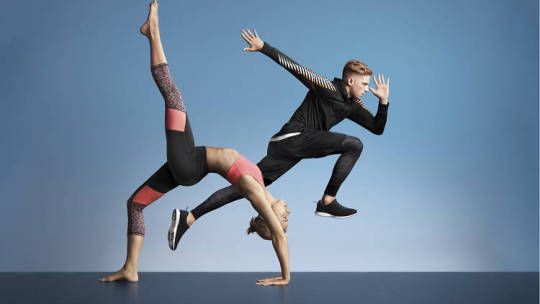
The Latest research coverage on Activewear Market provides a detailed overview and accurate market size. The study is designed considering current and historical trends, market development and business strategies taken up by leaders and new industry players entering the market. Furthermore, study includes an in-depth analysis of global and regional markets along with country level market size breakdown to identify potential gaps and opportunities to better investigate market status, development activity, value and growth patterns. Access Sample Report + All Related Graphs & Charts @: https://www.advancemarketanalytics.com/sample-report/16944-global-activewear-market
Major & Emerging Players in Activewear Market:- Nike, Inc. (United States), Adidas AG (Germany), Asics Corporation (Japan), Puma Se (Germany), Phillips-Van Heusen Corporation (United States), Columbia Sportswear Company (United States), Dick's Sporting Goods, Inc. (United States), Gap Inc. (United States), North Face, Inc. (United States), Under Armour, Inc. (United States). The Activewear Market Study by AMA Research gives an essential tool and source to Industry stakeholders to figure out the market and other fundamental technicalities, covering growth, opportunities, competitive scenarios, and key trends in the Activewear market. Active wear is the apparel which are used by athletes or individuals performing physical activities. It improves the performance during sports and other activities. These type of apparel also prevents muscles strains and injuries as they provide proper support and comes with excellent fitting. Active wear comes with various features such as breathability, quick drying, static resistance, and thermal resistance which are boosting the market growth.
The titled segments and sub-section of the market are illuminated below: by Type (Ready to Wear, Fashion Outer, Pants & T-Shirts, Rash Guard, Wet Suit & Swim Wear, Shoes (Sports Shoes, Aqua Shoes, Aqua Socks)), End users (Men, Women), Material type (Polyester, Nylon, Neoprene, Polypropylene, Spandex, Cotton, Others), Distribution channel (Online, Offline) Market Trends: Implementation of Technology in Active Wear
Opportunities: Initiatives to Promote Health and Fitness
Manufacturing of Active Wear Using Sustainable Methods
Market Drivers: Inclination of consumers towards health consciousness is fueling the market growth. There has been rising number of individuals participating in physical activities. Hence, the usage of sports products are increasing. In addition the increasing disposable income is contributing towards the market growth.
Challenges: Availability of Counterfeit Products Enquire for customization in Report @: https://www.advancemarketanalytics.com/enquiry-before-buy/16944-global-activewear-market Some Point of Table of Content: Chapter One: Report Overview Chapter Two: Global Market Growth Trends Chapter Three: Value Chain of Activewear Market Chapter Four: Players Profiles Chapter Five: Global Activewear Market Analysis by Regions Chapter Six: North America Activewear Market Analysis by Countries Chapter Seven: Europe Activewear Market Analysis by Countries Chapter Eight: Asia-Pacific Activewear Market Analysis by Countries Chapter Nine: Middle East and Africa Activewear Market Analysis by Countries Chapter Ten: South America Activewear Market Analysis by Countries Chapter Eleven: Global Activewear Market Segment by Types Chapter Twelve: Global Activewear Market Segment by Applications What are the market factors that are explained in the Activewear Market report?
– Key Strategic Developments: Strategic developments of the market, comprising R&D, new product launch, M&A, agreements, collaborations, partnerships, joint ventures, and regional growth of the leading competitors.
– Key Market Features: Including revenue, price, capacity, capacity utilization rate, gross, production, production rate, consumption, import/export, supply/demand, cost, market share, CAGR, and gross margin.– Analytical Tools: The analytical tools such as Porter’s five forces analysis, SWOT analysis, feasibility study, and investment return analysis have been used to analyze the growth of the key players operating in the market. Buy This Exclusive Research Here: https://www.advancemarketanalytics.com/buy-now?format=1&report=16944 Definitively, this report will give you an unmistakable perspective on every single reality of the market without a need to allude to some other research report or an information source. Our report will give all of you the realities about the past, present, and eventual fate of the concerned Market. Thanks for reading this article; you can also get individual chapter wise section or region wise report version like North America, Europe or Asia. Contact US : Craig Francis (PR & Marketing Manager) AMA Research & Media LLP Unit No. 429, Parsonage Road Edison, NJ New Jersey USA – 08837 Phone: +1 201 565 3262, +44 161 818 8166 [email protected]
#Global Activewear Market#Activewear Market Demand#Activewear Market Trends#Activewear Market Analysis#Activewear Market Growth#Activewear Market Share#Activewear Market Forecast#Activewear Market Challenges
0 notes
Text
1 note
·
View note
Text
Business Strategies Driving the Sports Apparel Market Growth: 2023-2030
The global sports apparel market size was valued at USD 195.50 billion in 2022 and is projected to grow from USD 203.26 billion in 2023 to USD 271.77 billion by 2030, exhibiting a CAGR of 4.24% during the forecast period.
The market has registered steady growth in recent years due to factors, such as new product launches and rising participation in sports activities in countries, such as India, the U.S., and others. The growing preference for outdoor recreational activities among the young population has contributed significantly towards the sales of sports apparel. This aspect, along with rising health consciousness and growing inclination towards sports will accelerate the global sports apparel market growth.
Fortune Business Insights™ presents this information in a report titled, "Global Sports Apparel Market, 2023-2030."
LIST OF KEY COMPANIES PROFILED IN THE REPORT
Nike, Inc. (U.S.)
Adidas AG (Germany)
Puma SE (Germany)
Lululemon Athletica, Inc. (Canada)
Under Armour, Inc. (U.S.)
Columbia Sportswear Company (U.S.)
Asics Corporation (Japan)
FILA Holdings Corp. (South Korea)
Mizuno (Japan)
LI Ning Company Limited (China)
Segmentation:
Tops & T-shirts Witness Strong Rise in Sales, Might Fuel Market Growth
Based on product, the global sports apparel market is divided into tops & t-shirts, trousers & tights, shorts, and others. The tops & t-shirts segments account for the largest market share and may register a strong CAGR during the forecast period. More women are taking part in athletics every year. More people are also participating in outdoor recreational activities. In addition, companies are introducing new top and t-shirt designs & collections. For example, in August 2022, luxury fashion brand H&M launched its new sportswear brand ‘H&M Move’. The brand will cater to the ever-growing demand for active wear among consumers. The new lineup consists of functional tops, lightweight jackets, and a wide range of tights and bras, along with garments designed to train and run.
Growing Participation of Women in Sports and Recreational Activities to Boost Sports Apparel Adoption
Based on demography, the market is segmented into men, women, and kids. The women segment is predicted to account for a sizeable market share. The growing percentage of women participating in sports and other outdoor recreational activities will fuel the adoption of tights, sports tops, and other garments. Many companies are launching new products to cater to the new market space.
For instance, in August 2021, ONLY, one of the leading European fashion brands for women, entered the sports apparel segment with its new collection “Only Play”. This launch was aimed at strengthening its position as a fashion-forward brand in the market by providing a wide range of products to meet the rising demand from millennial women. The collection includes tops, tights, tank tops, shorts, and other items with technical specialties, such as removable and non-removable padding, racerback style, functional pockets, and windproof breathability to offer stability and comfort to women while performing their daily activities.
Growing Chain of Retail Outlets to Improve Product Sales
In terms of distribution channel, the industry is bifurcated into online and offline. The offline segment is expected to capture a larger share during the forecast timeline. Many reputed brands, such as Nike, Lululemon, Adidas, and more are opening their own retail outlets. For instance, as per Nike's 2022 annual report, the brand had 344 stores in the U.S. and 702 stores outside the country. These initiatives will spur the growth of offline distribution channels.
Report Coverage:
The global sports apparel market report makes a detailed analysis of the industry and underlines crucial factors, such as competitive landscape, prominent companies, product types, share analysis, demographics, distribution channels, and market sizing. The research report also offers insights into the latest market trends and highlights important industry development in regions including North America, Europe, Asia Pacific, and South America. In addition, the report encompasses several other factors contributing to the market's growth.
Drivers and Restraints:
Comfort and Breathability Offered by Sports Apparel to Drive Market Development
Several companies are launching a wide range of sportswear materials that can absorb sweat and keep the person cool and dry. Fabrics, such as cotton, spandex, microfiber, nylon, polyester, and calico are popularly used to make this apparel as these fabrics can make workout sessions comfortable by supporting body movements with optimal elasticity. For instance, in September 2022, Nike unveiled its latest innovation in the materials used to manufacture apparel called “Forward”, which is manufactured with the help of a new production process that uses lesser steps and consumes lesser energy. The material has a lower density as compared to that of woven or knitted, making it more comfortable for athletes and a suitable alternative for climate-conscious clients.
Fluctuating Raw Materials Prices to Restrain Market Development
Yarns and other fabrics used to make sports apparel have a time-consuming production process. According to the United Nations Conference on Trade and Development, the production of textiles takes place in a few major countries, such as India, China, Bangladesh, Pakistan, Brazil, and Turkey. For example, the India Brand Equity Foundation (IBEF) stated that India was the largest cotton producer, manufacturing around 362.18 lakh bales during the cotton season of 2021-22. The production of cotton is seasonal and depends on natural factors, such as rainfall, humidity, solar radiation, and others. Furthermore, the production of synthetic fibers, such as nylon, rayon, and polyester uses crude oil in large quantities. These factors are anticipated to restrain the market progress.
Regional Insights:
Rising Influence of Sports to Boost North American Market Growth
The global sports apparel industry is segmented into North America, Europe, Asia Pacific, South America, and Middle East & Africa. North America accounted for the largest market share owing to the growing consumer base for these products in the U.S. The region is heavily influenced by sports, such as basketball, football, and baseball, which has contributed significantly to the market progress. Furthermore, introduction of new products by market players will also fuel the demand for sports apparel in this region. For instance, in July 2022, DRAKE'S NOCTA announced plans to launch its new basketball apparel collection in collaboration with Nike. The collection will include performance-based garments, such as workout hoodies, tees, shorts, and socks.
APAC Region Witnesses Robust Participation in Sports
The Asia Pacific region is also holding a sizeable share in the global sports apparel market. The region is noticing robust participation in sports. The influence of sports is also growing in countries, such as India, Bangladesh, China, Australia, and others. The introduction of new sports events will further boost the sales of sportswear products. For instance, in September 2022, the Basketball Federation of India (BFI) unveiled the Indian National Basketball League (INBL) 5×5, which will see Bengaluru, Chandigarh, Chennai, Delhi, Mumbai, and Kolkata play over three rounds before heading to the playoffs. Such developments will increase the global sports apparel market share.
Competitive Landscape:
Companies operating in the sports apparel market are innovating their existing product lineup with the help of new launches. They are also increasing their regional presence by introducing advanced technologies in their products. These organizations are partnering with sports events and leagues to widen its customer reach. For instance, in May 2022, Adidas teamed up with Balenciaga to introduce a new collection at the latter’s resort 2023 runway show in New York. It was instantly made available to shop at Balenciaga’s website. Furthermore, new technologies, such as layering styles and texture blocking will enhance the demand for high-tech sports clothing in the forecast period.
Notable Industry Development:
June 2022 - Puma introduced its new PUMA App in India in collaboration with renowned Indian cricketer Virat Kohli. The launch was to cater to the growing number of online shoppers and high adoption of direct-to-consumer channels across the country. India became the first market to have access to the app developed by the German sportswear giant, which will help the brand expand its presence.
Browse Detailed Summary of Research Report:
0 notes
Text
Bamboo Clothing Market Navigating Business with CAGR of 9.1% with Revenue of $3 Billion by 2032
The bamboo clothing market size was valued at $1.3 billion in 2022, and is estimated to reach $3 billion by 2032, growing at a CAGR of 9.1% from 2023 to 2032.
Request The Sample PDF Of This Report: https://www.alliedmarketresearch.com/request-sample/75312
Clothing created from bamboo fabric is referred to as bamboo clothing. The pulp of bamboo plants is converted into a textile material called bamboo fabric, which may be used to create a variety of garments. Bamboo clothing has become more popular in recent years due to its sustainability, comfort, and other benefits. The softness, breathability, and moisture-wicking qualities of bamboo cloth are well recognized. Its velvety feel is sometimes likened to expensive textiles such as cashmere or silk. The inherent breathability of fabric allows air to flow and heat to escape, thus, it helps to keep the body at low temperature. In addition, bamboo fabric has moisture-wicking properties, which enable it to swiftly absorb and drain away perspiration, making it ideal for athletic wear or hot, humid climates.
Clothing made of bamboo is a great organic option, and it offers several advantages over cotton. Bamboo cloth has a texture similar to silk and is softer than cotton. It is an organic, chemical- and pesticide-free product that is naturally antibacterial and hypoallergenic. In addition, it quickly absorbs moisture, keeping the user dry and odor-free. Clothes made of pure bamboo can dry twice as fast as those made of cotton. Bamboo clothing keeps user warm in the winter and cool in the summer, making it suitable for year-round wear.
There are several environmental advantages to wearing bamboo apparel. Bamboo plants grow incredibly quickly and do not need pesticides or fertilizers to produce a profitable yield. They can endure both drought and flood situations and need little water. Bamboo is a sustainable and renewable resource due to its capacity for self-renewal. The old shoots are being regularly replaced by new ones.
Another advantage of bamboo is that, more than trees, it contributes a substantial amount of oxygen to the environment. Bamboo planting may lessen soil erosion and desertification as well as the amount of carbon dioxide in the air. Bamboo trees are a fantastic alternative for planting in high erosion locations such as riverbanks and regions vulnerable to mud slides due to their intricate root systems. Moreover, they are appropriate for planting in places that have seen severe deforestation and soil degradation. Bamboo pulp is used to make bamboo cloth. There is no chlorine used in the bleaching of the cloth. Bamboo cloth is simple to color, and dyeing techniques that use less water than traditional dyeing techniques may be used without resorting to harsh chemicals.
Buy Now@ https://www.alliedmarketresearch.com/checkout-final/5372341f5cc81dd65c06f5c4e9d77a6c
Profit margins for a store selling bamboo apparel range from 25% to 50%. Profits may be made in this area, but to do so, enterprises are required to make the right purchases and keep labor costs within reasonable bounds. In addition, geography has a significant impact on pricing. Increase in the profit margins is made possible by renting a facility for a reasonable, more affordable price. Initially, while a firm is just getting off the ground, advertising costs are much higher. Rise in demand for eco-friendly clothes, and lack of technical innovation in bamboo clothing, the profit margin is consequently relatively high due to limited supply of raw materials for bamboo clothing.
The bamboo clothing market analysis is on the basis of type, end-user, distribution channel, and region. On the basis of product type, the bamboo clothing industry is categorized into t-shirts and shirts, pants, activewear, coats and jackets, dress, undergarments, and others. On the basis of end user, it is categorized into men, women, and kids. On the basis of distribution channel, the bamboo clothing market is segmented into supermarkets and hypermarkets, independent retail stores, e-commerce, and specialty stores. On the basis of region, the market is analyzed across North America (the U.S., Canada, and Mexico), Europe (Germany, France, the UK, Italy, Spain, and Rest of Europe), Asia-Pacific (China, India, Japan, South Korea, Australia, and Rest of Asia-Pacific), and LAMEA (Latin America, Middle East, and Africa).
Continuous innovations in the fashion industry and consumer inclination toward sustainability are some of the major bamboo clothing market trends. The major players operating in the global bamboo clothing are Ettitude Holdings, Inc., Hara The Label Pty Ltd, Terrera, Spun Bamboo LLC, Tasc Performance, Bamboo Clothing Ltd, Free Fly Fishing Company, LLC, Cozy Earth, LLC, Royal Apparel Inc., and Cariloha, Inc.
According to Roshan Deshmukh, Manager, Food & Beverages, Allied Market Research, “The market for bamboo clothing is expected to boost in the Asia-Pacific market due to a rise in consumer demand toward sustainable clothing options. Moreover, the aesthetic properties of bamboo clothing compared to traditional materials such as wool and cotton result in market growth during the forecast period. Furthermore, breathability, UV protection property, antimicrobial property, and excellent moisture-wicking properties, among other properties offered by bamboo clothing is attracting athletes to wear bamboo activewear.”
Inquiry Before Buying @ https://www.alliedmarketresearch.com/purchase-enquiry/75312
Key findings of the study On the basis of product type, the undergarments segment is anticipated to grow at a CAGR of 10.22% during the forecast period. On the basis of end user, the women user segment is estimated to witness significant growth, registering a CAGR of 8.59% during the forecast period. On the basis of distribution channel, the independent retail stores segment garners the highest bamboo clothing market share in 2022 On the basis of region, North America was the dominant region in 2022, occupying a major share of the market.
0 notes
Text
Empowering Independence with Adaptive Clothing Market: Enhancing Daily Living for All

The adaptive clothing market refers to the production and distribution of clothing specifically designed to address the unique needs of individuals with physical disabilities, limited mobility, or other challenges that may affect dressing independently. These garments are engineered with innovative features and functional designs to enhance comfort, ease of use, and overall quality of life for people facing mobility issues. The adaptive clothing market has gained significant traction in recent years, as it caters to a growing demand for inclusive fashion and promotes inclusivity and independence for individuals with disabilities.
Market Overview:
The adaptive clothing market has experienced substantial growth and transformation due to evolving consumer demands, increased awareness of accessibility issues, and advancements in textile technology. This market encompasses a wide range of adaptive clothing options, including adaptive tops, bottoms, shoes, underwear, and outerwear. The garments are typically designed with features such as open-back designs, adjustable closures, magnetic fasteners, and Velcro straps to facilitate easy dressing and undressing. Additionally, the use of stretchable and breathable fabrics, specialized cuts, and strategically placed zippers and buttons further enhance functionality.
Market Drivers:
Growing Aging Population: With the global population getting older, there is an increased prevalence of mobility-related issues and disabilities, driving the demand for adaptive clothing.
Rising Disability Awareness: Greater awareness of disability rights and inclusivity has led to a surge in demand for adaptive clothing, as people recognize the importance of accessible fashion for individuals with disabilities.
Technological Advancements: Ongoing advancements in textile engineering, such as the development of smart fabrics, antimicrobial materials, and sensory integration technologies, have expanded the possibilities for innovative adaptive clothing solutions.
Inclusive Fashion Initiatives: Fashion brands and designers have recognized the importance of inclusive fashion and are actively incorporating adaptive clothing lines into their offerings, thus boosting the market growth.
Market Challenges:
Limited Awareness: Despite growing awareness, many potential customers and caregivers remain unaware of the availability and benefits of adaptive clothing, posing a challenge to market expansion.
Cost Factors: Some adaptive clothing items can be relatively expensive due to the specialized design, materials, and manufacturing processes involved, making them less accessible to certain demographics.
Design Constraints: Creating adaptive clothing that is both functional and aesthetically appealing can be challenging, as designers need to strike a balance between meeting functional needs and incorporating fashionable elements.
Market Segmentation:
The adaptive clothing market can be segmented based on various factors, including:
Product Type:
a. Tops and Shirts b. Bottoms and Trousers c. Dresses and Skirts d. Underwear and Bras e. Shoes and Footwear f. Outerwear and Jackets g. Others
End-User:
a. Men b. Women c. Children
Distribution Channel:
a. Online Retail b. Physical Stores c. Specialty Stores d. Institutional Sales (hospitals, care facilities, etc.)
Regional Analysis:
The adaptive clothing market has witnessed significant growth across various regions, including:
North America: The region has a well-established market for adaptive clothing, driven by a high level of disability awareness, robust healthcare infrastructure, and supportive government initiatives.
Europe: European countries have been at the forefront of inclusive fashion, leading to a substantial market for adaptive clothing. The region benefits from progressive disability policies and a strong emphasis on social inclusion.
Asia Pacific: This region offers significant growth potential due to a large population, increasing disposable income, and rising awareness about adaptive clothing options.
Rest of the World: Developing regions such as Latin America, the Middle East, and Africa are also witnessing a gradual increase in demand for adaptive clothing, fueled by improving healthcare infrastructure and evolving consumer attitudes.
Key Players:
Several key players operate in the adaptive clothing market, including:
Tommy Hilfiger Adaptive Izzy Camilleri Adaptive Clothing Silvert's Adaptive Clothing and Footwear Open Style Lab Adaptive Clothing Showroom Able2Wear Runway of Dreams Adaptive Clothing Market Buck & Buck CareZips
Conclusion:
The adaptive clothing market is witnessing remarkable growth as it addresses the fashion and functional needs of individuals with disabilities and limited mobility. With the support of technological advancements, growing awareness, and inclusive fashion initiatives, the market is poised to expand further, ensuring that individuals with disabilities can access clothing that promotes comfort, independence, and inclusivity.
0 notes